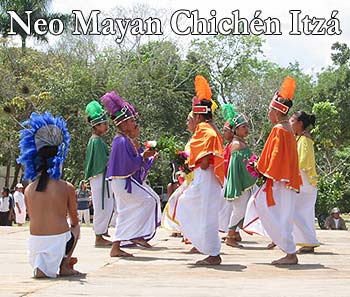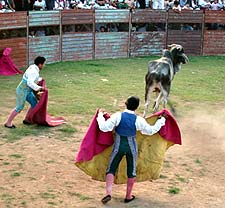 |
 |
 |
|
|||

Neo Mayan Chichén Itzá By Sara Harris 6/21/2002 Before Columbus, Chichén Itzá was the metropolis of the ancient Maya. Guide: Get out your maps. Here. Did everyone get a map? Does anyone else need a map? Now, it's one of the biggest tourist attractions in Mexico. Everyday, guides from the beaches of Cancún and Playa del Carmen dump buses of tourists onto the white limestone temples and pyramids that pop up from the flat plains of the Yucatán Peninsula. Tourist: "Dad, I'm gonna start climbing. Aunt Marie, Uncle Jim, turn around and wave... excellent!" This is the usual scenario. But once a year, tourism in "Mayaland" is transformed. When you enter the ruins, you run into a huge pyramid with 364 really steep stairs and an altar at the top. At the bottom is a pair of enormous serpent heads. Maya architects built this temple almost 2,000 years ago. Their calculations were so precise that once a year, when the sun sets, the steps form triangles of shadows that connect exactly with the head of the serpent. A complete snake of light and shadow emerges on the stone staircase. People come from all over to see it. Some people come for more. Hunbatz Men: "It's like the cosmic calling -- the cosmic calling. It's a phone, it's calling, and the people begin to come. This is Hunbatz Men. He's runs a series of mystic -- well, let's call them "correspondence schools." He calls them "Maya Mystery Schools." And people attend them in places as far away as Finland and Japan. Hunbatz charges a couple thousand dollars a head to guide people through the sunset at Chichén Itzá on the spring equinox. Men: "When the sun is exactly in the center of the earth, the energy is up and down, north and south -- that is science. But when they pray, that is religion. In the Western culture, science goes in one direction and religion goes in another direction. Hunbatz Men followers aren't the only ones here looking for something. Thousands of people come to tune in to the frequency of the ancient energy. You've got New-Age pilgrims dressed in white, armed with rattles, feathers and crystals. Gnostics from Chile, neo-Maya from Japan, neo-Aztecs from Mexico City. And there's Danny, a back-packer from South London, who I interrupted in the act of... Danny: "Khung ging, or space palm. It's just Khan meditation, really. It's just a good place to do it. I've read quite a bit about shamanism, but I've kind of slacked off on the Inca-Aztec-Maya stuff. All we know is that a serpent turns up. That's about all we know. Do you know any more? By 4:00 p.m., the lawn at Chichén Itzá looks like a rock concert. The local theater group is wrapping up a re-enactment of a virgin sacrifice. It's dubious as to whether the ancient Maya ever actually conducted virgin sacrifices, but the re-enactment has become the "hula show" of Maya culture. Official voices boom out of the speakers, ordering us to sit down so that everyone can see. Speakers: "Vamos a disfrutar el fenómeno archaeo-astronomico, el equinoccio de la primavera." But the clouds are in the way. People start asking each other if anyone can see the shadow. When the sun breaks through the clouds and hits the pyramid just right, it actually does form a snake down the wall of the staircase, and you think, "How did they do that?" Crowd: "Ahh! Ohh...hey! Mucho!" OK, I'll admit it, I really can feel the frequency of the energy here. And all these people looking for spiritual renewal, they've probably found it. I mean, it's spring, and there's the music and the sacrifice, and there are the costumes and the explanations. It's like a Mexican Disneyland for a day. There are 10 times more German tourists here than there are Maya locals. But it's still a sacred Maya site. So where are the locals? Well, 5 miles away, in small town of Chichimila, where everyone is Maya, there is a big fiesta going on. All the villages in Yucatán have some version of the spring fiesta del pueblo. Mayor: Y ahorita va a comenzar la musica... This is the mayor of Chichimila. He's explaining that typical Yucatecan music has its roots in Spain. But the music is just a prelude the main event, which also is typical: the Yucatecan bullfight. Ten bulls bump up against each other while cowboys isolate the first victim. The whole town gets settled on the makeshift bleachers with popcorn, chicharrones and other goodies, waiting for the first bull to be sent down the chute But the bull seems more interested in escaping the torreadores than in fighting. After a few rounds and several swipes with a dull sword, he surrenders. The cowboys finish him off and deliver the body to the butcher just outside the ring.
You could even say that the Maya don't practice authentic Maya culture, but then, that's what Maya culture is: a mixture of centuries of indigenous tradition and Spanish influence, with a garnish of pop-culture on top, and an explosion of tourist culture just around the corner. In the Yucatan, I'm Sara Harris for The Savvy Traveler.
|
|
Search
Savvy Traveler
|
|
